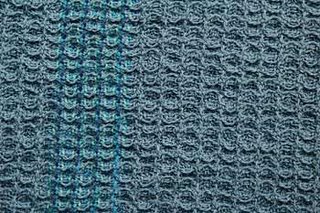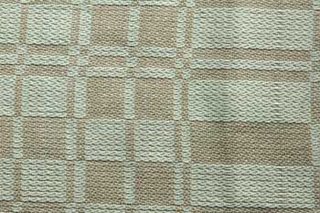 Today's towel is a 4-shaft waffle weave. The top photo is unwashed and the bottom photo is washed. What a difference! Under tension on the loom the waffle cells don't show up very well but as soon as the tension is released, you get these nice regular waffle cells. Then, when the fabric is washed it really shrinks and you get these more irregular cells. On this towel, the width on the loom was 15 inches and after washing it was 11 inches, or shrinkage of about 25%. When calculating your warp, if you want 11 inches you have to weave 15, so you have to add a whopping 35% to the desired width! It's a nice soft, absorbent towel, though.
Today's towel is a 4-shaft waffle weave. The top photo is unwashed and the bottom photo is washed. What a difference! Under tension on the loom the waffle cells don't show up very well but as soon as the tension is released, you get these nice regular waffle cells. Then, when the fabric is washed it really shrinks and you get these more irregular cells. On this towel, the width on the loom was 15 inches and after washing it was 11 inches, or shrinkage of about 25%. When calculating your warp, if you want 11 inches you have to weave 15, so you have to add a whopping 35% to the desired width! It's a nice soft, absorbent towel, though. This 4-shaft waffle weave is threaded as a point twill (1-2-3-4-3-2-1). The tie-up, though, uses five treadles and is done in such a way that it produces long warp and weft floats that form the outlines of the square cells. The treadling is like a point twill but with five treadles (1-2-3-4-5-4-3-2-1). This towel was done in 8/2 cotton sett at 20 epi - a little looser than you would use for a point twill. The nice thing about this structure is that you can put on a long warp threaded as a point twill and weave some things with point twill then, by changing the tie-up (and possibly setting a little looser) you can then weave some waffle weave on the same warp.
This 4-shaft waffle weave is threaded as a point twill (1-2-3-4-3-2-1). The tie-up, though, uses five treadles and is done in such a way that it produces long warp and weft floats that form the outlines of the square cells. The treadling is like a point twill but with five treadles (1-2-3-4-5-4-3-2-1). This towel was done in 8/2 cotton sett at 20 epi - a little looser than you would use for a point twill. The nice thing about this structure is that you can put on a long warp threaded as a point twill and weave some things with point twill then, by changing the tie-up (and possibly setting a little looser) you can then weave some waffle weave on the same warp.Supposedly, waffle weave also makes a good blanket. I wove the hem area on this with 16/2 cotton, otherwise the tabby hem would have been wider than the waffle weave towel and would have looked ugly. There are three other variations of waffle weave that we did in class - and I'll talk about them in future posts.









